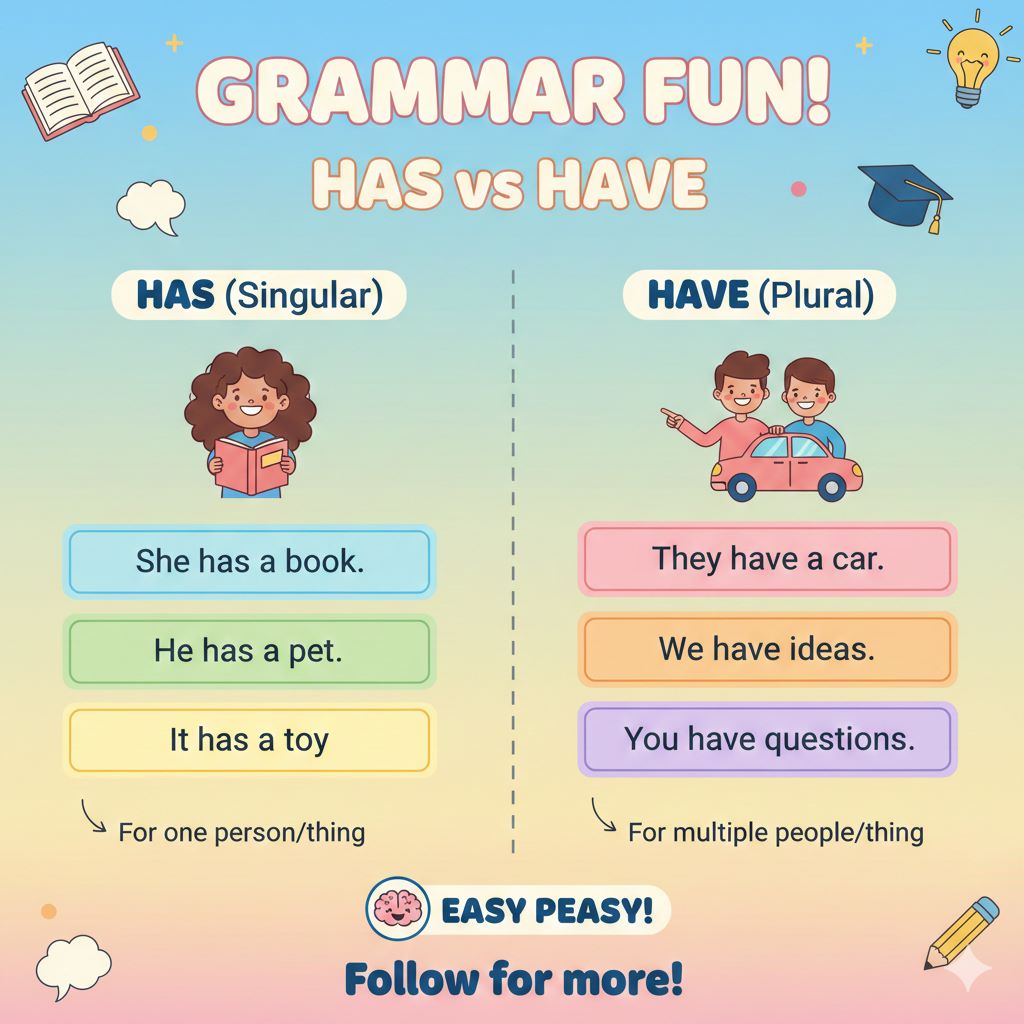“Has” vs. “Have”: What's the Difference?
Don’t get confused between “has” and “have” anymore. Learn the simple difference and make English grammar easy to understand.
English grammar is not usually tricky. But sometimes it gets confusing, especially when two words look similar but aren’t used the same way.
One of such confusions is between “has” and “have.”
That’s why many of us pause while writing, thinking, “Do I say he has or he have?” Many of us are like that. Even native speakers slip up here!
Both words come from the same verb “to have.” It means to own, possess, or experience something. But their usage is not the same.
So, in this article, I’ll break down the difference between “has” and “have” in the simplest way possible. Along with examples to help you digest it.
What “has” means (with examples)
The word “has” is the third-person singular form of the verb “to have.” That means you use “has” when your subject is he, IMGshe, it, or a singular noun.
It usually shows possession, ownership, or experience in the present tense.
Here are some examples:
- She has a beautiful voice.
- He has a new job.
- My cat has green eyes.
- His friend has a car.
In simple words, when your subject is one person or one thing, use “has.”
What “have” means (with examples)
The word “have” is used with I, you, we, and they, or any plural noun. It’s also the base form of the verb “to have.”
Like “has,” it shows possession, relationships, or experiences. But the subject decides which one you use.
Here are some examples:
- I have a meeting today
- You have a great sense of humor
- We have two dogs
- They have finished their homework
In simple words, when your subject is plural (or I, we, they, you), then use “have.”
How to use has and have in sentences
Here’s a clearer way to understand when to use has vs. have in different sentences. So your writing stays sharp and correct.
Using with other verbs and tenses
Denoting possession is quite simple, but we often use other verbs in these sentences as well. This complicates our sentences even further.
The following are some ways we can do this quite easily.
To indicate a possibility
Has and have are also used in sentences when we want to tell about something that is supposed to happen in the future.
For example:
- You have to go get the car.
- He has to go for a walk.
To describe a completed action
Another way we use “has or have” in conversations is to indicate that an action has just been completed.
That’s what we call the present perfect tense. It is a complicated time relationship that often confuses people. But it is easy when you get the basic idea.
For example:
- We have waited for this moment for a long time.
- He has told me the situation before.
- She has played like this her whole life.
Do you know?
All writing tools, like a paragraph generator, are usually trained on all such rules. That’s why they do not make grammatical mistakes like this.
They are always spot on.
Using this tool, you can also learn how to use “has and have” in sentences. Create content with it and read it to know better.
Choose based on the subject
In all these situations, we use has or have in the same old manner.
Has is used when the subject is singular. That means he, she, it, or any singular noun.
- Example: She has a new idea.
Use have when the subject is plural or is one of I, you, we, or they.
- Example: They have several ideas.
Getting this right makes sure your sentences are natural and grammatically clean.
You can easily take care of all these rules and complications by simply using a grammar checker.
You can just paste your writing in it, and it will point out all the mistakes in it, including “has and have” mistakes.
Conclusion
The difference between “has” and “have” is quite small. But its impact on how natural and correct your English sounds is big.
Both come from the same verb “to have.” But their usage depends entirely on the subject.
When you write or speak, just remember this:
- Singular subject (he, she, it) → use has
- Plural subject (I, you, we, they) → use have
It’s the simplest way to remember this.
Once you get used to spotting the subject, you’ll never pause to think which one fits again.
Frequently asked questions
1. Can we use “has” and “have” in the same sentence?
Yes! There are a few sentences where we use both has and have. Both can appear together when referring to different subjects.
For example, “She has told me that they have already left.”
2. Why do some people say “has got” instead of “has”?
That’s because there are more than one ways to speak English. UK vs. US English are a bit different.
In British English, “has got” often replaces “has” for possession
For example: “She has got a bike.”
But in American English, “has” alone is more common.
For example: “She has a bike.”
3. How can I quickly check if I’ve used “has” or “have” correctly?
That’s easy. I have a simple trick that will help you check this out.
Just try replacing the subject with “he.”
If it fits, use has. If not, use have.
For example: “He has” → correct, “He have” → wrong.

